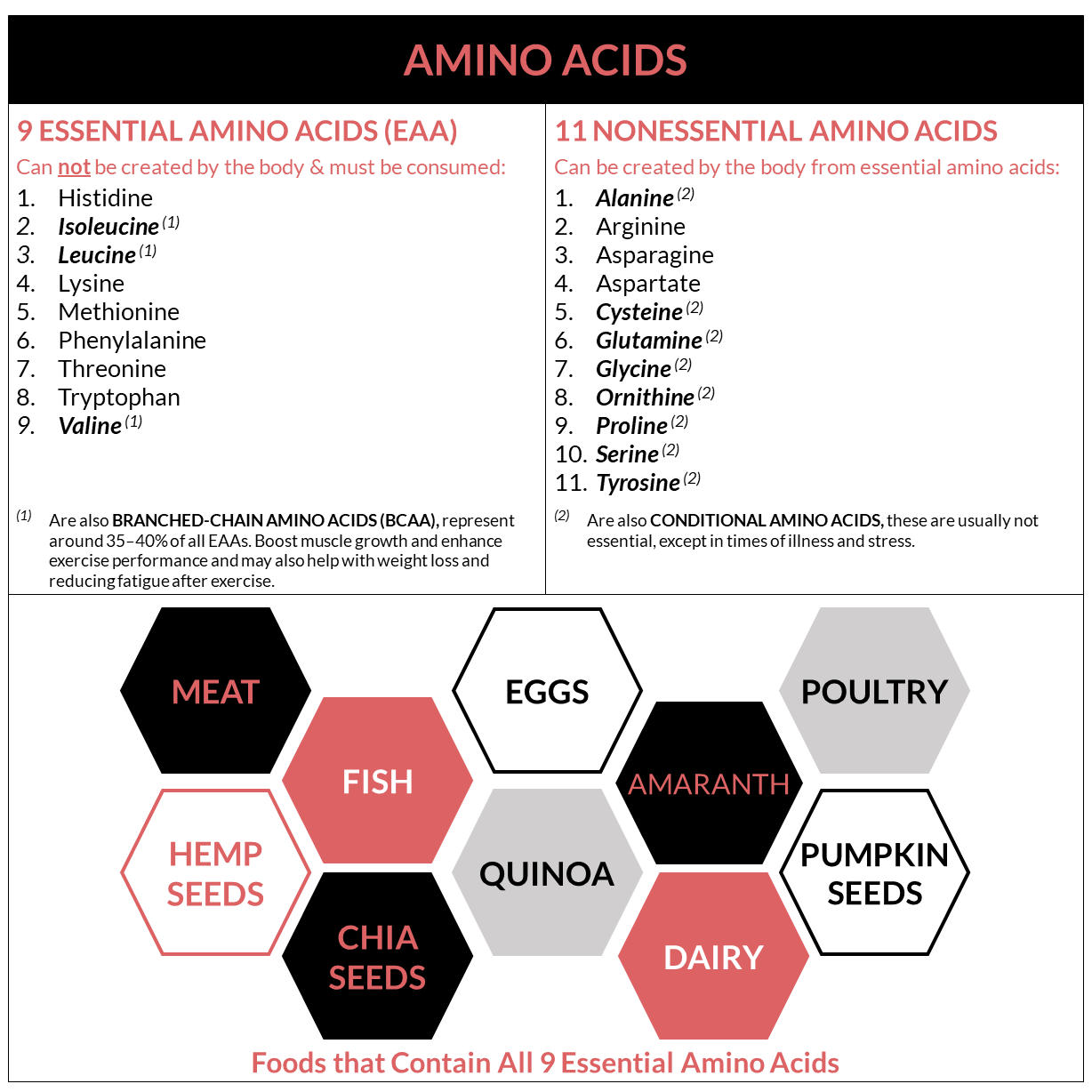
When proteins are digested or broken down, amino acids are left. The human body uses amino acids to make proteins to help the body:
- Break down food;
- Grow;
- Repair body tissue; and
- Perform many other body functions.
Amino acids can also be used as a source of energy by the body.
Amino acids are classified into three groups:
- Essential amino acids;
- Nonessential amino acids; and
- Conditional amino acids.
ESSENTIAL AMINO ACIDS
Essential amino acids (EAAs) cannot be made by the body. As a result, they must come from food. The 9 essential amino acids are:
- Histidine;
- Isoleucine;
- Leucine;
- Lysine;
- Methionine;
- Phenylalanine;
- Threonine;
- Tryptophan; and
- Valine.
Essential amino acids can not be created by the body & must be consumed.
NONESSENTIAL AMINO ACIDS
Nonessential means that our bodies can produce the amino acid, even if we do not get it from the food we eat. Nonessential amino acids include: alanine, arginine, asparagine, aspartic acid, cysteine, glutamic acid, glutamine, glycine, proline, serine, and tyrosine.
Nonessential essential amino acids can be created by the body from essential amino acids
CONDITIONAL AMINO ACIDS
- Conditional amino acids are usually not essential, except in times of illness and stress.
- Conditional amino acids include: arginine, cysteine, glutamine, tyrosine, glycine, ornithine, proline, and serine.
You do not need to eat essential and nonessential amino acids at every meal, but getting a balance of them over the whole day is important. A diet based on a single plant item will not be adequate, but we no longer worry about pairing proteins (such as beans with rice) at a single meal. Instead we look at the adequacy of the diet overall throughout the day.
Eight of the nonessential essential amino acids are also considered conditional amino acids. Conditional amino acids are usually not essential, except in times of illness and stress.
BRANCHED-CHAIN AMINO ACIDS
Branched-Chain Amino Acids (BCAAs) consist of three essential amino acids:
- Leucine
- Isoleucine
- Valine
These amino acids are grouped together because they are the only three amino acids to have a chain that branches off to one side.
Like all amino acids, BCAAs are building blocks your body uses to make proteins.
BCAAs are considered essential because, unlike nonessential amino acids, your body cannot make them. Therefore, it is essential to get them from your diet.
The three BCAAs are leucine, isoleucine, and valine. All have a branched molecular structure and are considered essential to the human body.
How do branched-chain amino acids work?
BCAAs make up a large chunk of the body’s total amino acid pool. Together, they represent around 35–40% of all essential amino acids present in your body and 14–18% of those found in your muscles.
Contrary to most other amino acids, BCAAs are mostly broken down in the muscle, rather than in the liver. Because of this, they are thought to play a role in energy production during exercise.
BCAAs play several other roles in your body. First, your body can use them as building blocks for protein and muscle. They may also be involved in regulating your blood sugar levels by preserving liver and muscle sugar stores and stimulating your cells to take in sugar from your bloodstream.
What’s more, BCAAs may help reduce the fatigue you feel during exercise by reducing the production of serotonin in your brain (10Trusted Source).
Out of the three, leucine is thought have the biggest impact on your body’s capacity to build muscle proteins.
Meanwhile, isoleucine and valine seem more effective at producing energy and regulating your blood sugar levels.
Your body can use BCAAs to build muscle protein and produce energy. They may also have an effect on your brain that reduces fatigue.
References
Dietzen DJ. Amino acids, peptides, and proteins. In: Rifai N, ed. Tietz Textbook of Clinical Chemistry and Molecular Diagnostics. 6th ed. St Louis, MO: Elsevier; 2018:chap 28.
Trumbo P, Schlicker S, Yates AA, Poos M; Food and Nutrition Board of the Institute of Medicine, The National Academies. Dietary reference intakes for energy, carbohydrate, fiber, fat, fatty acids, cholesterol, protein and amino acids. J Am Diet Assoc. 2002;102(11):1621-1630. PMID: 12449285 pubmed.ncbi.nlm.nih.gov/12449285/.
Review Date 3/11/2021
Updated by: Meagan Bridges, RD, University of Virginia Health System, Charlottesville, VA. Also reviewed by David Zieve, MD, MHA, Medical Director, Brenda Conaway, Editorial Director, and the A.D.A.M. Editorial team.